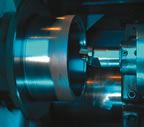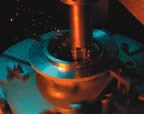Competitive Testing Process Helps Manufacturer Take The Bite Out Of Cycle Times
To find a line of indexable inserts that would improve cycle times and provide increased tool life, this company invited eight tool manufacturers to test their inserts on turning applications on ductile iron workpieces machined at the company's facility.
Share


Autodesk, Inc.
Featured Content
View More

.png;maxWidth=45)
DMG MORI - Cincinnati
Featured Content
View More

ECi Software Solutions, Inc.
Featured Content
View More





Like all manufacturers, Fairfield Manufacturing (Lafayette, Indiana) is constantly exploring ways to maintain its competitive edge and streamline its costs. For the company, achieving these goals has always meant pursuing imaginative ideas. An example is when it implemented a competitive bidding process to find a line of indexable inserts that would improve cycle times and provide increased tool life.
Founded in 1919, Fairfield is a large independent designer and manufacturer of gears, custom gear sets and power transmission assemblies. It serves a diverse and growing customer base of companies in road construction, forestry, agriculture, mining, rail applications, public transportation, aerial platforms, marine work stations and defense.
The company began its quest by inviting eight tool manufacturers to test their inserts on turning applications on ductile iron workpieces machined at the company's facility. Through this process, the company was able to make an educated decision on an insert that would have a significant impact on its output, quality and convenience.
Every day for 6- to 8-hour shifts during a 3-week period, competitors rotated through the company's 600,000-square-foot manufacturing and engineering facility, recording results on a form prepared by the company.
"We offered this opportunity to the different tool manufacturers when it became clear that coating technologies were changing and alternatives to inserts we were currently using were available," says Steve Brower, manufacturing technical manager at Fairfield.
One such technology tested was from Walter Waukesha (Waukesha, Wisconsin). The indexable bi-color Tiger-Tec inserts feature two coatings to maximize performance in cast and nodular iron machining applications. The gold-colored periphery coating serves as a wear indicator, creating a visible clue to assist the operator in assessing the need to index the insert.
"The top (functional) coating is aluminum oxide applied by an ‘AlphaPhase' coating process, which bonds the top coating to the insert," says Bob Willey, sales engineer at Walter Waukesha. "Combined with the lubricity factor created by the smooth surface, this bonding reduces heat caused by friction from the material being removed. This allows the inserts to run at elevated speeds, thus reducing cycle times."
During the testing period, processes were changed to improve performance. In several cases, the manufacturer downsized inserts and increased the surface feet per minute.
"We selected these inserts based on the performance and reduction in cycle times we saw in several different applications with the inserts," Mr. Brower says.
Fairfield uses these inserts in turning applications on varying grades of ductile iron. In these applications, tool life has increased and cycle times have dropped as much as 65 percent compared to previous inserts used, the company says.
Three of the applications in which Tiger-Tec inserts have been implemented include the housing for a wheel drive in a man lift, a gearbox housing and a labyrinth cap that is an assembly for a cooling tower.
The material used for the wheel drive is ductile iron D5506. Used on a Warner & Swasey 2SE–15, the insert cuts rough OD, rough flange face, finish OD, finish flange face, rough face, rough bore, finish face and finish bore on the 10-inch workpiece. The depths of the rough cuts are 0.18 inch and the finish cuts are 0.04 inch. Previously, the operator could run two to three parts at a cycle time of 3 minutes and 55 seconds before indexing the tool. With the new inserts, however, the operator can run the entire job (25 pieces) at 2 minutes and 32 seconds before indexing. This equates to a 733 to 1,150 percent increase in tool life and a 35 percent decrease in cycle time.
The second workpiece, a gearbox housing with a dimension of 21.375 inches, is machined from ductile iron D7003 on a Warner & Swasey 42-inch vertical turning lathe. Prior to using Tiger-Tec, one to two parts were machined per index. Using the inserts' designation CNMA 644 WAK20 for roughing to 0.24 inch and CNMA 432 WAK20 for finishing to 0.035 inch, the operator achieves six parts per index—a 200 to 500 percent improvement in tool life. On this application, Mr.. Brower comments, "Fewer changes by the operator means greater time savings and increased cost efficiencies."
The labyrinth cap workpiece is also ductile iron and is 9.5 inches in diameter. It is machined on a Mazak Multiplex 630, and the insert helps the operator achieve at least double the productivity of the previous insert used.
"The tool lasts much longer," Mr. Brower says. "In fact, we hardly ever change it. The speeds and feeds are much higher than before using the new inserts. The insert portion of the cycle is only 25 seconds versus 38 seconds with the previous insert."
The company uses insert designations WNMA 433 WAK20 (roughing) and WNMA 432 WAK10 (finishing) to rough and finish the OD, machine face and flange and perform rough and finish bore. In both flat top inserts, the rougher cuts to a depth of 0.125 inch and the finisher cuts to 0.040 inch.
"We had many insert options available during our testing process from quality tool manufacturers," Mr. Brower says. "Tiger-Tec offered us the most effective way to obtain significant speed, quality and tool life improvement."
Read Next
Building Out a Foundation for Student Machinists
Autodesk and Haas have teamed up to produce an introductory course for students that covers the basics of CAD, CAM and CNC while providing them with a portfolio part.
Read More5 Rules of Thumb for Buying CNC Machine Tools
Use these tips to carefully plan your machine tool purchases and to avoid regretting your decision later.
Read MoreRegistration Now Open for the Precision Machining Technology Show (PMTS) 2025
The precision machining industry’s premier event returns to Cleveland, OH, April 1-3.
Read More


















.png;maxWidth=150)













.jpg;maxWidth=300;quality=90)








